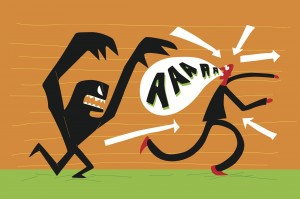
Ooh, what a palaver over the depression and exercise story! Such a lot of words have been written about the study published in the BMJ last week, including by me.
The study itself was well conducted but frankly disappointing (for us readers and the researchers themselves), finding as it did that a specific treatment to encourage depressed people to exercise didn’t have much impact on reducing their symptoms. However, it was really the poor quality of the press release and the subsequent misleading headlines that got everyone’s collective goat.
Stories like this usually cause ructions because they challenge established beliefs that individuals have, in many cases beliefs they’ve developed because of personal experience (I ran myself happy type stories, of which there are many).
Over the last few days, a lot of people have referred to the established evidence-base that proves that exercise helps with depression, but as usual most of them haven’t actually referenced their off-hand comments. So I thought it might be helpful to provide a quick overview of the good quality information (guidelines, systematic reviews, randomised trials and patient information) that currently exists in this area. And boy there’s quite a lot of it!
After 10 minutes of searching I’d found well over 100 guidelines, 250 systematic reviews and 1,450 randomised controlled trials. Far too much for one elf to summarise! What you have below is a snapshot of the evidence. Certainly not a systematic summary, but hopefully enough to give you a flavour of the evidence for exercise as a treatment for depression.

Can we really exercise our way out of depression?
Guidelines
NICE have 3 guidelines relevant to depression: one aimed at adults, one at children and the third focused on depression amongst people who also have another chronic physical health problem. All 3 of these guidelines recommend exercise for people with depression.
Here’s what the NICE guideline recommends for adults:
Physical activity programmes for people with persistent sub threshold depressive symptoms or mild to moderate depression should be delivered in groups with support from a competent practitioner and consist typically of three sessions per week of moderate duration (45 minutes to 1 hour) over 10 to 14 weeks (average 12 weeks).
Taken from p.21 of Depression – clinical guideline 90 (PDF). NICE, Oct 2009.
Here’s what NICE recommend for children and young people:
A child or young person with depression should be offered advice on the benefits of regular exercise and encouraged to consider following a structured and supervised exercise programme of typically up to three sessions per week of moderate duration (45 minutes to 1 hour) for between 10 and 12 weeks.
Taken from p.18 of Depression in children and young people – clinical guideline 28 (PDF). NICE, Sep 2005.
The guidance from NICE about depression when it occurs in people with chronic physical health problems is a bit more complicated:
Physical activity programmes for patients with persistent subthreshold depressive symptoms or mild to moderate depression and a chronic physical health problem, and for patients with subthreshold depressive symptoms that complicate the care of the chronic physical health problem, should:
- be modified (in terms of the duration of the programme and frequency and length of the sessions) for different levels of physical ability as a result of the particular chronic physical health problem, in liaison with the team providing care for the physical health problem
- be delivered in groups with support from a competent practitioner
- consist typically of two or three sessions per week of moderate duration (45 minutes to 1 hour) over 10 to 14 weeks (average 12 weeks)
- be coordinated or integrated with any rehabilitation programme for the chronic physical health problem.
Taken from p.22 of Depression with a chronic physical health problem – clinical guideline 91 (PDF). NICE, Oct 2009.
North of the border, SIGN have published a guideline specifically about managing depression without using drugs and there’s a section on exercise that recommends structured exercise as a treatment option for patients with depression:
The effects of both aerobic exercise (e.g. walking and jogging) and anaerobic exercise (e.g. weight training) have been examined in younger and older adults with depression, with a large variety of intervention types delivered across a range of settings. There is a larger evidence base for aerobic exercise than for anaerobic exercise. Limitations of the evidence base include small sample sizes in many studies and the use of volunteer subjects who may be particularly motivated to adhere to an exercise programme.
Taken from p.10 of Non-pharmaceutical management of depression in adults – guideline 114 (PDF). SIGN, Jan 2010.

Is there anything nicer than a run through the countryside with your loved ones?
Systematic reviews
The Cochrane review updated last in 2010 found that:
Exercise did seem to improve the symptoms of depression, but we cannot be sure exactly how effective it is, or the most effective type of exercise. The evidence suggests that exercise probably needs to be continued in the longer-term for benefits on mood to be maintained.
Mead GE, Morley W, Campbell P, Greig CA, McMurdo M, Lawlor DA. Exercise for depression. Cochrane Database of Systematic Reviews 2009, Issue 3. Art. No.: CD004366. DOI: 10.1002/14651858.CD004366.pub4.
Cochrane have also published a review looking at exercise for depressed children and young people, but that has less conclusive findings:
Whilst there appears to be a small effect in favour of exercise in reducing depression and anxiety scores in the general population of children and adolescents, the small number of studies included and the clinical diversity of participants, interventions and methods of measurement limit the ability to draw conclusions. It makes little difference whether the exercise is of high or low intensity. The effect of exercise for children in treatment for anxiety and depression is unknown as the evidence base is scarce.
Larun L, Nordheim LV, Ekeland E, Hagen KB, Heian F. Exercise in prevention and treatment of anxiety and depression among children and young people. Cochrane Database of Systematic Reviews 2006, Issue 3. Art. No.: CD004691. DOI: 10.1002/14651858.CD004691.pub2.
A review by Blake et al concluded that physical exercise may be useful for treatment of depressive symptoms in older people but that further research was needed.
Blake H, Mo P, Malik S, Thomas S. How effective are physical activity interventions for alleviating depressive symptoms in older people? A systematic review Clinical Rehabilitation 2009; 23(10): 873-887. [Abstract]. Or read the free CRD summary of this review.
A review by Daley et al concluded that it was uncertain whether exercise reduced the symptoms of post-natal depression.
Daley A, Jolly K, MacArthur C. The effectiveness of exercise in the management of post-natal depression: systematic review and meta-analysis. Family Practice 2009; 26(2): 154-162. [Abstract]. Or read the free CRD summary of this review.
A review by Herring et al found that exercise reduced depressive symptoms in people with chronic illness who do not have a diagnosis of depression. The effect was greatest in patients with mild-to-moderate depression.
Herring MP, Puetz TW, O’Connor PJ, Dishman RK. Effect of exercise training on depressive symptoms among patients with a chronic illness: a systematic review and meta-analysis of randomized controlled trials. Arch Intern Med. 2012 Jan 23;172(2):101-11. [Abstract]
Randomised controlled trials
However, lots of studies do find that depression does not have a positive impact on depression. I blogged about the TREAD trial back in April and said at the time that:
The headline from this research is that the physical activity promoting intervention in primary care did not lead to any clinical benefit in terms of depressive symptoms.
A pragmatic randomised controlled trial to evaluate the cost-effectiveness of a physical activity intervention as a treatment for depression: the treating depression with physical activity (TREAD) (PDF). Health Technol Assess 2012;16(10):1–164.
Patient information
And finally, if you are looking for a good quality piece of patient information on the subject, I would recommend the NHS Choices section on Exercise and depression. http://www.nhs.uk/Livewell/Depression/Pages/Depressionexercise.aspx

Get on your bikes kids!
Conclusion
The evidence for exercising when depressed is ’emerging’. It’s certainly not conclusive yet, but when you take into account all of the other health benefits that are gained from exercise, it is hard to see why doctors wouldn’t recommend that people with depression get out and participate in some form of regular physical activity.

I agree with your conclusion whole-heartedly as one who has benefited significantly in terms of mood and well-being by doing regular, pleasurable, and varied exercise on a daily basis. For me personally, far more effective than any anti-depressant (and I have tried many different kinds in the past), because you feel YOU are taking control of your own mood (depression being linked with ‘learned helplessness’ as coined by Seligman) and can attribute your increased sense of well-being to your OWN efforts, rather than to a pill. I would emphasize that exercise needs to be PLEASURABLE because, with the best intentions in the world, if we repeatedly do something we do not particularly enjoy, we are unlikely to sustain our efforts. Enthusiasm can peter out which defeats the object, as this is really all about lifestyle change. An exercise buddy can be great for many of us, as can listening to uplifting music during our ‘workout’. Alternatively, a solitary walk in nature can be a truly spiritual journey – a time to notice, to reflect, and to dream a little, and – at the risk of sounding a bit ‘hip’ – a feeling of at one-ness with nature and with the cosmos! Poppy (Psychologist/Mental Health Peer Specialist)
What a great site this is. Apart from any physical/ psycho-neurological benefits of exercise I think the reasons it can help alleviate depression, anecdotally at least (because as you mention the research is gathering but not conclusive) is that it involves a task which has a conclusion.
Completion of worries through either no longer worrying/ruminating or active problem solving is what depression stops people doing. If I’m depressed I might worry about stuff that can’t be solved/completed right now because its far in the future or gone into the past. Or I might worry about something but not take practical action to “switch that worry off” by actively problem solving because I feel helpless and hopeless.
So life during a depression is full of unresolved anxieties with the resultant build up of stress and resultant exhaustion that causes. But the pattern of an exercise session is different; we might call it genuinely anti-depressive. During exercise we create a “stress” on the body but we ignore it, work through it, even see it as desirable but then, unlike the other stresses in our life we switch off this particular “stress” (which is what exercise essentially is) by completing the exercise session. This pattern of positive completion, this control of and eventually switching off (of ) the stress response and the sense of satisfaction (and dopamine release) might for some spread to their wider life, a pattern for rising out of the depression perhaps. Anyway, Just some thoughts..
Keep up the great work.
Mark
I attend a swimming group of people with a variety of health problems, including MS, arthritis, new joints, post accident, etc. We have a physio poolside who devises a set of exercises custom made for each person. We all swear by it. Many people with the chronic conditions have also been, or are still are, depressed and it gives us a lift. As beneficial is the coffee club afterwards. This informal group is driven by myself and a vicar’s wife and is effectively a peer support group, which aids our mental wellbeing.